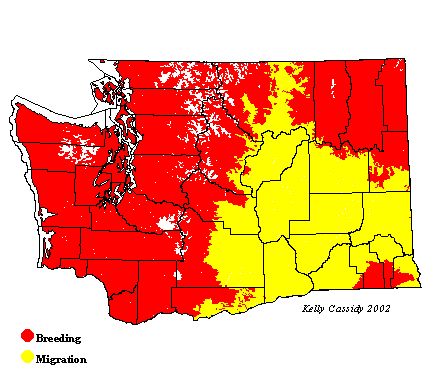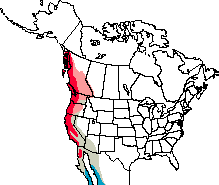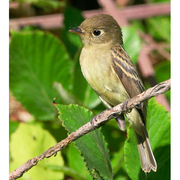Western Flycatcher
General Description
The Western Flycatcher is yellowish underneath, with the yellow extending up to the throat. It has a broad bill, and its lower mandible is yellow. The white eye-ring extends to the back in a teardrop shape. The juvenile has two buffy wing-bars that change to white as it matures. These features are distinctive, as is its voice, making separation from other Empidonax species in its range relatively easy.
Habitat
The habitat of Western Flycatchers includes both deciduous and mixed deciduous-coniferous forests. These birds are generally found in the sub-canopy of heavy, wet forest. Streamsides and shady areas with shrubby understory are often used. Along the outer coast, they are the only Empidonax flycatchers commonly found in the dense, wet rain forest of this region.
Behavior
The Western Flycatcher generally watches from a perch in the lower or middle canopy, and flies out to catch prey in the air. It also hovers in front of foliage or twigs and gleans prey from their surfaces. This species can be very hard to see, but can be found readily once its call is known--a distinct, upslurred suweet, or a high, thin tseep.
Diet
Western Flycatchers eat mostly flying insects as well as some crawling insects.
Nesting
Western Flycatchers usually select natural sites such as trees for nesting. Very occasionally they nest under man-made bridges or eaves. Nests usually have some sort of shelter from above. Natural nesting sites include tree stumps and upturned tree roots, which are typically closer to the ground than nests on man-made objects. The female builds the nest of moss, grass, rootlets, bark, and lichen, and lines it with hair and feathers. She usually incubates three to four eggs for 14 to 15 days. Both parents feed the young, which leave the nest at about 15 days. The young stay near the nest for a few days after fledging.
Migration Status
These medium-distance migrants arrive in Washington in late April or early May. Most birds leave in late July and early August; however, some stay into mid-September. They head to the lowlands of western and southern Mexico for the winter.
Conservation Status
The Western Flycatcher is listed on the Audubon Washington watch list. The Breeding Bird Survey has recorded a significant decline in Washington from 1980-2000. While man-made structures may add potential nesting sites, logging and clearing underbrush degrades the habitat.
When and Where to Find in Washington
Western Flycatchers are common throughout their Washington range. They breed in forests from low to moderate elevations throughout Washington, including streamside forests in the steppe zone of eastern Washington. Cordilleran Flycatchers, or intergrades between the two, may breed in coniferous forests in the Blue Mountains of southeastern Washington.
 Abundance
Abundance
| Ecoregion | Jan | Feb | Mar | Apr | May | Jun | Jul | Aug | Sep | Oct | Nov | Dec |
|---|---|---|---|---|---|---|---|---|---|---|---|---|
| Oceanic | ||||||||||||
| Pacific Northwest Coast | U | F | F | F | U | R | ||||||
| Puget Trough | U | C | C | C | F | U | ||||||
| North Cascades | U | C | C | C | C | U | ||||||
| West Cascades | U | C | C | C | F | U | ||||||
| East Cascades | R | U | U | U | U | R | ||||||
| Okanogan | F | F | F | F | ||||||||
| Canadian Rockies | U | U | U | U | ||||||||
| Blue Mountains | F | F | F | F | U | |||||||
| Columbia Plateau | U | U | U | U | U |
Washington Range Map

North American Range Map


Family Members
 Olive-sided FlycatcherContopus cooperi
Olive-sided FlycatcherContopus cooperi Western Wood-PeweeContopus sordidulus
Western Wood-PeweeContopus sordidulus Alder FlycatcherEmpidonax alnorum
Alder FlycatcherEmpidonax alnorum Willow FlycatcherEmpidonax traillii
Willow FlycatcherEmpidonax traillii Least FlycatcherEmpidonax minimus
Least FlycatcherEmpidonax minimus Hammond's FlycatcherEmpidonax hammondii
Hammond's FlycatcherEmpidonax hammondii Gray FlycatcherEmpidonax wrightii
Gray FlycatcherEmpidonax wrightii Dusky FlycatcherEmpidonax oberholseri
Dusky FlycatcherEmpidonax oberholseri Western FlycatcherEmpidonax difficilis
Western FlycatcherEmpidonax difficilis Black PhoebeSayornis nigricans
Black PhoebeSayornis nigricans Eastern PhoebeSayornis phoebe
Eastern PhoebeSayornis phoebe Say's PhoebeSayornis saya
Say's PhoebeSayornis saya Vermilion FlycatcherPyrocephalus rubinus
Vermilion FlycatcherPyrocephalus rubinus Ash-throated FlycatcherMyiarchus cinerascens
Ash-throated FlycatcherMyiarchus cinerascens Tropical KingbirdTyrannus melancholicus
Tropical KingbirdTyrannus melancholicus Western KingbirdTyrannus verticalis
Western KingbirdTyrannus verticalis Eastern KingbirdTyrannus tyrannus
Eastern KingbirdTyrannus tyrannus Scissor-tailed FlycatcherTyrannus forficatus
Scissor-tailed FlycatcherTyrannus forficatus Fork-tailed FlycatcherTyrannus savana
Fork-tailed FlycatcherTyrannus savana

